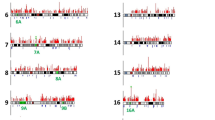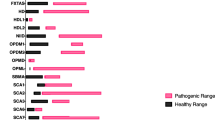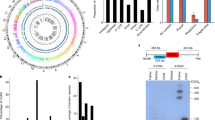Abstract
CAG/CTG repeat expansions cause at least 12 different neurological disorders, and additional disorders of this type probably exist. Using the repeat expansion detection (RED) assay, we identified an expanded CAG/CTG repeat in a 50-year-old woman with an autosomal dominant syndrome with prominent progressive sensory neuropathy. The expansion could not be accounted for by any of the CAG/CTG repeats known to undergo expansion. To identify the locus of the expansion, we created a PCR array to assess the repeat length of all repeats of eight or more CAG or CTG triplets in the human genome. The expansion was localized to a repeat contained in an intron of a Genscan-predicted gene, 185 nt downstream of a predicted exon that is conserved through mouse. The closest experimentally verified gene in the region (TNIK, encoding a serine/threonine kinase) occurs approximately 63 Kb downstream from the repeat. The length of the expansion in the proband is 98 triplets. This repeat is not expanded in the proband’s cousin (the only other affected family member for whom DNA is currently available) and no expansions were detected in a set of 230 patients with movement disorders of unknown cause. An expanded allele containing 58 triplets was detected in a single control individual, and no other expansions were detected in a set of 255 controls. The normal repeat length ranges from 5 to 30 triplets, with 8 triplets the most common allele. Our results suggest that this new repeat expansion is probably not the direct cause of the phenotype in the proband. Whether the repeat contributes to the patient’s phenotype, or is associated with another phenotype, remains to be determined.





Similar content being viewed by others
References
Altschul SF, Gish W, Miller W, Myers EW, Lipman DJ (1990) Local alignment search tool. J Mol Biol 215:403–410
Baldi P, Brunak S, Chauvin Y, Pedersen AG (1999) Structural basis for triplet repeat disorders: a computational analysis. Bioinformatics 15:918–929
Bhattacharyya D, Kundu S, Thakur AR, Majumdar R (1999) Sequence directed flexibility of DNA and the role of cross-strand hydrogen bonds. J Biomol Struct Dyn 17:289–300
Burge C, Karlin S (1997) Prediction of complete gene structures in human genomic DNA. J Mol Biol 268:78–94
Cagnoli C, Michieletto C, Matsuura T, Ashizawa T, Margolis RL, Holmes SE, Gelera C, Migone N, Brusco A (2004) Detection of large pathogenic expansions in FRDA1, SCA10, and SCA12 genes using a simple fluorescent repeat-primed PCR assay. J Mol Diagn 6:96–100
Holmes SE, O’Hearn E, McInnis MG, Kwak NG, Gorelick-Feldman DA, Kleiderlein JK, Callahan C, Sherr M, Sharp AH, Sumner AJ, Ashworth RG, Ananth U, Seltzer W, Vieria-Saecker AM, Epplen JT, Reiss O, Ross CA, Margolis RL (1999) Expansion of a novel CAG trinucleotide repeat in the 5′ region of PPP2R2B is associated with SCA12. Nat Genet 23:391–392
Holmes SE, O’Hearn E, Callahan C, Hwang HS, Rosenblatt A, Ingersoll-Ashworth RG, Fleisher A, Stevanin G, Brice A, Potter NT, Ross CA, Margolis RL (2001) A CTG trinucleotide repeat expansion in Junctophilin 3 is associated with Huntington’s Disease-Like 2 (HDL2). Nat Genet 29:377–378
Holmes SE, O’Hearn E, Brahmachari SK, Choudhry S, Srivastava AK, Jain S, Ross CA, Margolis RL (2002) SCA12. In: Pulst S (ed) Genetics of movement disorders. Academic, San Diego, pp 121–132
Kent WJ, Sugnet CW, Furey TS, Roskin KM, Pringle TH, Zahler AM, Haussler D (2002) The human genome browser at UCSC. Genome Res 12:996–1006
Koob MD, Moseley ML, Schut LJ, Benzow KA, Bird TD, Day JW, Ranum LP (1999) An untranslated CTG expansion causes a novel form of spinocerebellar ataxia (SCA8). Nat Genet 21:379–384
Loots G, Ovcharenko I (2004) rVista 2.0: evolutionary analysis of transcription factor binding sites. Nucleic Acids Res 32(Web Server Issue):W217–W221
Manto MU (2005) The wide spectrum of Spinocerebellar Ataxias (SCAs). Cerebellum 4:2–6
Margolis RL (2002) The Spinocerebellar Ataxias: order emerges from chaos. Curr Neurol Neurosci Rep 2:447–456
Missirlis PI, Mead CL, Butland SL, Ouellette BF, Devon RS, Leavitt BR, Holt RA (2005) Satellog: a database for the identification and prioritization of satellite repeats in disease association studies. BMC Bioinformatics 6:145
Mulvihill DJ, Edamura KN, Hagerman KA, Pearson CE, Wang YH (2005) Effect of CAT or AGG interruptions and CpG methylation on nucleosome assembly upon trinucleotide repeats on spinocerebellar ataxia, type 1 and fragile X syndrome. J Biol Chem 280:4498–4503
Pedersen AG, Baldi P, Chauvin Y, Brunak S (1998) DNA structure in human RNA polymerase II promoters. J Mol Biol 281:663–673
Rozen S, Skaletsky HJ (2000) Primer3 on the WWW for general users and for biologist programmers. In: Krawetz S, Misener S (eds) Bioinformatics methods and protocols: methods in molecular biology. Humana, Totowa, pp 365–386
Schalling M, Hudson TJ, Buetow KW, Housman DE (1993) Direct detection of novel expanded trinucleotide repeats in the human genome. Nat Genet 4:135–139
Seixas AI, Maurer MH, Lin M, Callahan C, Ahuja A, Matsuura T, Ross CA, Hisama FM, Silveira I, Margolis RL (2005) FXTAS, SCA10, and SCA17 in American patients with movement disorders. Am J Med Genet A 136:87–89
Siepel A, Bejerano G, Pedersen JS, Hinrichs A, Hou M, Rosenbloom K, Clawson H, Spieth J, Hillier LW, Richards S, Weinstock GM, Wilson RK, Gibbs RA, Kent WJ, Miller W, Haussler D (2005) Evolutionarily conserved elements in vertebrate, insect, worm, and yeast genomes. Genome Res 15:1034–1050
Tan EC, Lai PS (2005) Molecular diagnosis of neurogenetic disorders involving trinucleotide repeat expansions. Expert Rev Mol Diagn 5:101–109
Tsutsumi T, Holmes SE, McInnis MG, Sawa A, Callahan C, DePaulo JR, Ross CA, DeLisi LE, Margolis RL (2004) Novel CAG/CTG repeat expansion mutations do not contribute to the genetic risk for most cases of bipolar disorder or schizophrenia. Am J Med Genet 124B:15–19
Wang YH, Griffith J (1995) Expanded CTG triplet blocks from the myotonic dystrophy gene create the strongest known natural nucleosome positioning elements. Genomics 25:570–573
Acknowledgments
We would like to thank our patients and their family members for their gracious cooperation with this study. We thank Dr. Elizabeth O’Hearn for helpful discussions, Alka Ahuja, Abdul Bachani, John Hwang, Lisa Gourley, Abhijit Agarwal, Debbie Pollard, and Marie Sonderman for technical assistance, and Dr. Judy Stone for advice and use of facilities. This work was funded by NIH NS38054 and NS16375.
Author information
Authors and Affiliations
Corresponding author
Electronic supplementary material
Rights and permissions
About this article
Cite this article
Holmes, S.E., Wentzell, J.S., Seixas, A.I. et al. A novel trinucleotide repeat expansion at chromosome 3q26.2 identified by a CAG/CTG repeat expansion detection array. Hum Genet 120, 193–200 (2006). https://doi.org/10.1007/s00439-006-0207-0
Received:
Revised:
Accepted:
Published:
Issue Date:
DOI: https://doi.org/10.1007/s00439-006-0207-0




